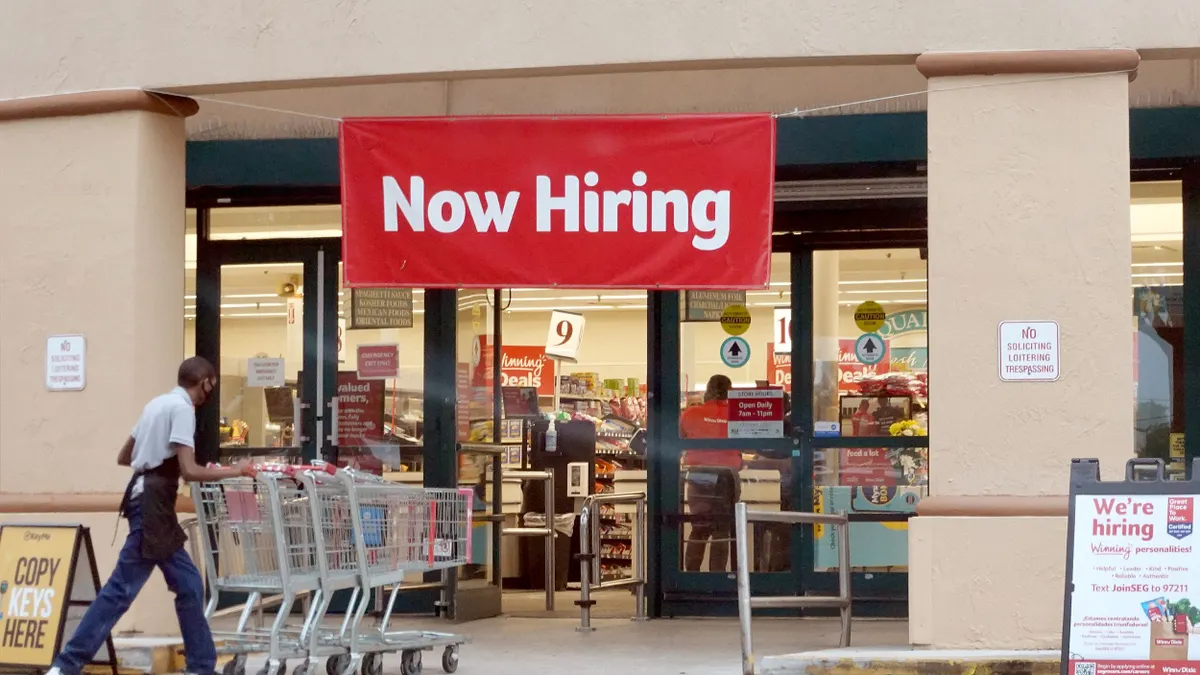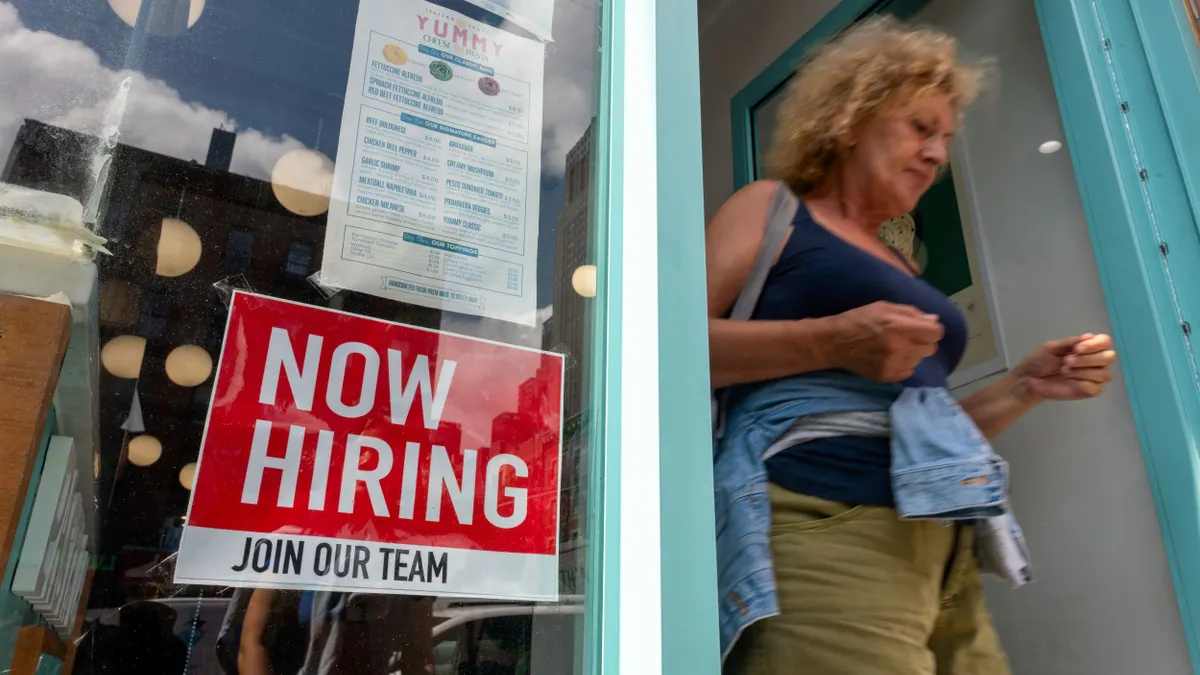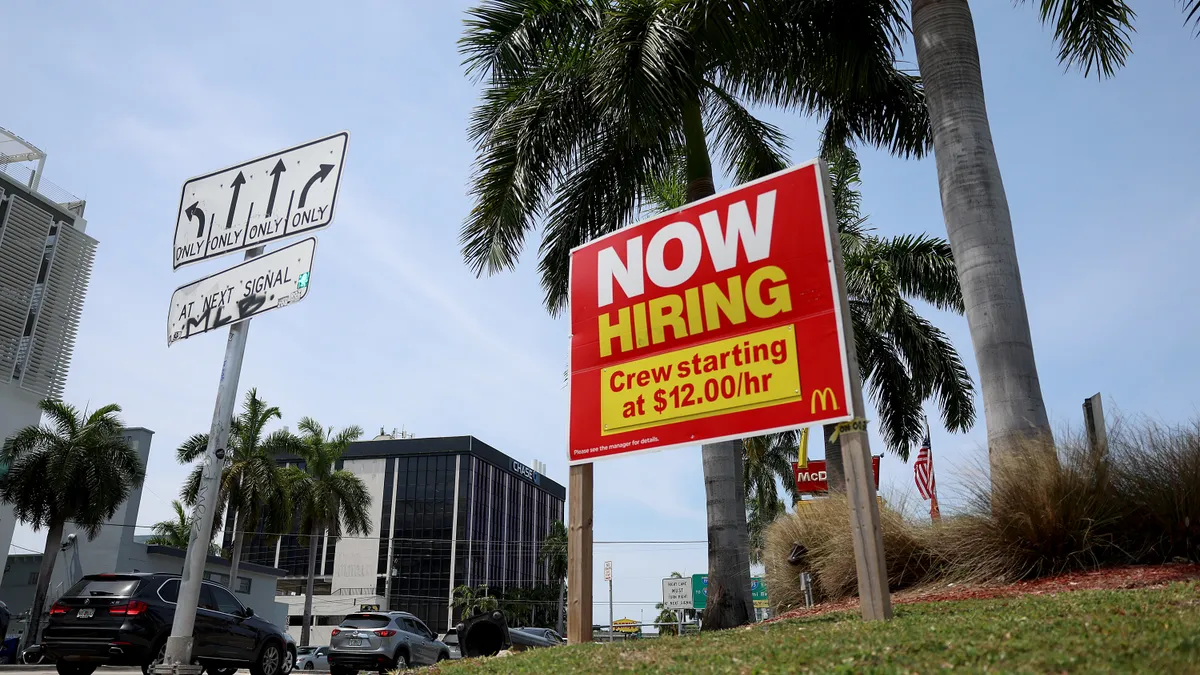Editor’s note: This story is part of the HR Dive Outlook on 2021, a series on the trends that will shape the industry in 2021. For a look at the business trends affecting other industries, see the Dive Outlook on 2021.
As recruiting leaders embark on a new year, it would be easy to overlook all of the ways the workplace and employment changed over the last nine months. While the calendar may have flipped to 2021, the pace of change is expected to remain about the same, according to multiple experts who spoke with HR Dive. For those in recruiting, it means another year of adjusting to a constantly-evolving environment.
"I think it's not necessarily a complete rewrite of the recruiting process for everybody but I think it's time to look and revise and improve and think about the process of improvement over time," Corey Berkey, vice president of human resources at JazzHR, told HR Dive. "I think there's going to be a lot of iteration going on here in the next 12 months."
New standards for inclusion, social responsibility and authenticity
The widespread social and economic impact of the pandemic, followed by a summer of protests against structural inequality, has changed the values of job seekers and employers. This has led to employers doing more in this space, and employees and prospective employees are demanding more as well.
One of the greatest drivers of structural inequity in the country is the workplace, where wages and representation in leadership are lower for those in underrepresented groups based on gender, race and other characteristics. Addressing this requires more attention to diversity and internal retrospection.
If your company is hiring in 2021, focus on bringing in diverse candidates, but also make sure to put the effort in after they're hired so they feel welcome and empowered to be their true selves at work, and actively solicit their feedback on how to improve in these areas.
"You've got to drive awareness for what these biases mean," Berkey said. "You've got to really help people expose their own weaknesses there, and you've got to really make sure that the people who are in your hiring teams understand it, appreciate it, are on the lookout for it, and are not afraid to call out if they see it."
The job market will be watching to see how companies take action on the promises they made this summer.
"You can't just check the box [and say] 'Oh, hey, we hired a few people from underrepresented backgrounds. We put pictures of them on our website. We did it.' No, people want more," Jon Stross, co-founder of Greenhouse Software, a popular ATS provider, told HR Dive.
"If we're talking about mitigating bias in your recruiting process, you have to structure your process," he continued. Recruiters should "interrogate" their processes, Stross said, collecting demographic data and identifying potential roadblocks. "There's not one answer, different companies are gonna have issues at different places."
A wider labor pool, but not infinite
With employers increasingly comfortable having remote workers, and many expecting to keep the practice in place after the pandemic, many believe it will widen the available talent pool.
While this may be the case, it will not be so easy for employers to open up to the entire world, or even the entire U.S. Each state has different employment laws, registration requirements and other standards that add complications for a company that is just starting to have remote employees working out of more different states.
"You got to know what you're getting into," Berkey said. "You've got to uncover those compliance risks, and you've got to make sure that you're prepared to comply in those areas, and that's a challenge in and of itself."
Increased transparency in the recruiting process
In addition to the rise of sites like Glassdoor, social media has created another channel for employees to share the reality of their work experiences. While it may be the social app du jour for its viral dance routines, TikTok also includes numerous workers posting video and photo evidence of their real-life experiences. For those doing the hiring, it means honesty and openness are key.
"Recruiters and hiring managers must be prepared to have authentic conversations with candidates and answer their questions about all aspects of the job and employee experience," Lauren Smith, vice president in the Gartner HR practice, told HR Dive via email. "Those that fail to have transparent, honest conversations will create challenges when candidates join the organization and realize that there is a mismatch between what they were told and what they experience on the job."
On top of that, the pandemic has shined a light on the responsibilities employers have to their employees. While the job market may have stagnated, employers' actions were under significant public scrutiny.
"As organizations make the critical shift from supporting employees as workers to improving their life overall, recruiting functions must ensure that the labor market understands the value the organization provides through employment," Smith said. "Specifically, this requires an intentional shift in employment branding strategy from talking about not just how the organization supports the employee experience but also helps people optimize their life experience."
During the recruiting process, while employers cannot directly approach subjects like families, spouses or workplace accommodations, they can make it clear that their company is willing to be flexible with people based on their needs.
"I think it's going to be much more about proactively sharing the tolerances of flexibility for your business," Berkey said. Recruiters can share a business' approach to workplace management and capture a new set of expectations.
Another way to be more transparent, for both parties in interviews, is encouraging natural behavior rather than the formalized conversations that often take place in these situations.
"I think that there is this still air of formality, that people feel like it's not an interview if it's not that, and that sucks," Berkey explained. Berkey would nix interview etiquette in favor of a more relaxed conversation. "I'm not hiring who you are when you're formal," he said. "I'm hiring who you are whenever you're under pressure, I'm hiring whoever you are whenever you are a real live human being."
The labor-market effects of the vaccine and economic recovery
In addition to potentially ramping up headcount on the recruiting team, the labor market may open up after the vaccine reaches a majority of the public. In addition to business activity picking up and employers — particularly those in hospitality, transportation and other industries affected by COVID-19 — posting more openings, workers are also more likely to be looking for new jobs.
"There was this prediction [that our] cup will overflow with candidates and it hasn't been the case," Berkey said. "It is not as as challenging to get candidates as it was in 2019, but I would say it is equally if not more challenging to get qualified candidates." Berkey said he's identified a surge in available talent in the market. "But a surge in candidates does not always correlate to a surge in candidate quality."
Berkey and his industry peers said many passive candidates and those who might be interested in looking elsewhere are holding off in large part because of the pandemic. "Those high quality candidates that we used to be able to pry loose from their current employers, their employers are saying 'I've got to keep these people!' So they're working twice as hard on retention of their top skilled talent."
If people are waiting, employers may see a sharp spike in voluntary departures as well.
"All the people with jobs stopped applying," Stross shared. "I'm convinced there's a giant pool of people who naturally would have moved companies. [...] The moment that all ends, everyone's going to [look to] quit."
The COVID-19 conversation
When it comes to the coronavirus, every recruiting conversation needs to include what the company is doing for employees right now, how it's organizing work spaces and what the timeline is for a return to the office for those who haven't been in, experts say.
"Recruiters should proactively share return-to-the-workplace plans, how they may vary by location and talent segment, and how it will impact their particular role," Smith said. "Recruiters should be equipped to share the upcoming decision points, who will be making these decisions, and how they will be communicated to employees." Additionally, recruiters and hiring managers may want to share details about virtual onboarding processes and the remote employee experience, Smith said.
The COVID-19 response and continued effort is also an opportunity to demonstrate more transparency, including about any negative events which occurred.
"Be honest about where you are as a company," Stross advised. "If you did layoffs, you gotta be honest about it. If you say, 'Hey, our company is on a D&I journey. We maybe aren't where we want to be.' It's okay to be honest candidates and tell them 'here's where we're actually at.'"
Virtual recruiting sticks around, but in-person should return
During the pandemic, recruiting technology took a leap forward in its adoption and presence throughout the recruitment process. This has been a boon for inclusion by decreasing the time investment required to engage in an interview process and making the process more accessible for people with disabilities or those who don't live close to urban centers where job opportunities are concentrated.
That employers and job seekers are much more familiar with the methods of virtual hiring processes will also help keep it alive in the future of work.
"All the things that we've learned over these nine months over how to do [virtual recruiting], people will continue to keep doing. We see huge volumes of people doing that," Stross said. "I think now people have gotten comfortable with it on both sides, candidates and companies."
However, many people believe in-person conversations are irreplaceable, and so many employers are likely eager to resume in-person recruiting and interviews when possible.
"I think that most companies, unless they were an entirely virtual company to begin with, still found a lot of value in bringing people into the office," Berkey said. "A lot of businesses I know can use that to sell the value of joining that team," he later added. He noted the value of nice office spaces equipped with technology and other perks such as snacks or recreation spaces.
Stross agreed. "I think that there's a great urge from lots of people to go back in-person and see each other, and so there will still be in-person interviews one day," Stross said.
Employment branding and onboarding, mostly online
With the expected proliferation of remote work, employers are going to need to get much better at onboarding virtually.
"I think what we're seeing is companies who used to think of onboarding was this finance and IT thing, get them on payroll and get them a computer," Stross said. It's now a "hardcore, managerial responsibility" of making the employee feel like part of the company, being intentional about making relationships within the organization, and getting them set up on communication and collaboration platforms, including "the right Slack channels."
"I think onboarding is sort of being reinvented more profoundly during this than even recruiting," Stross added.
In addition to navigating increased transparency and job-seeker demands, employers are also less able to demonstrate their culture to prospective employees through visits to the office for in-person interviews, tours of the building and other recruiting events such as open houses and career fairs. With more of the recruiting process occurring online, recruiting will need to get creative.
"It's really tempting to think that the main thing you have is the job description and your careers page," Stross shared. "So people spend a lot of time there, and they build videos. That's not good. And I heard that. But the truth is, you have like a dozen or two dozen touchpoints that happen with a person from the moment they apply through their first day."
With workforce strategists focused on employment branding, and more of the process moving online, employers need to get better at sharing their culture through virtual channels.
Top companies face the need to retool the candidate experience to attract job seekers, Stross said. "We still want to treat our candidates as if they're the prized commodity."




















